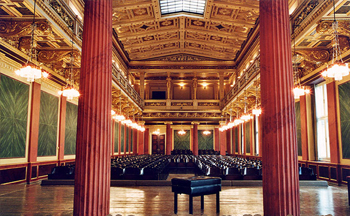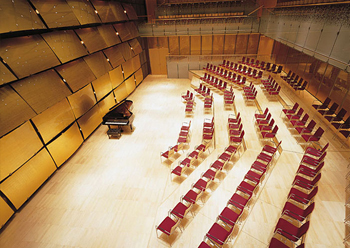MUK Symphony Orchestra
March 2026 | ||||||
|---|---|---|---|---|---|---|
Mo | Tu | We | Th | Fr | Sa | Su |
Human and Nature in the Musical Mirror – The MUK Symphony Orchestra performs Beethoven, Boulanger, and Shostakovich in cooperation with Jeunesse.
Stylistically diverse and rich in nuances, the MUK Symphony Orchestra appears in the Great Hall of the Musikverein Vienna. This time, the program spans from Dmitri Shostakovich’s Piano Concerto No. 1 in C minor, op. 35 (1933) — whose distinctive style the composer himself described as a “mocking challenge to the conservative and serious character of the classical concerto” — to the final composition by the young French composer Lili Boulanger (1893–1918), D’un matin du printemps, and finally to Ludwig van Beethoven’s Symphony No. 6 in F major (1808), a work that, like no other, opened the door to musical impressionism.
While in Beethoven’s Pastorale the theme of “nature” is embedded in an organic process disciplined within an abstract musical form, Lili Boulanger’s late-romantic contemplation of nature — she was, incidentally, the first woman to win the prestigious Prix de Rome in 1913 — is more restrained, deeply subjective, and yet of burning intensity.
Boulanger and Beethoven thus frame Shostakovich’s Piano Concerto, marked by sharp contrasts. Beyond its virtuosity, his music is always an expression of human emotions in a torn world, a message of resistance and will to survive — and therefore a musical document of timeless relevance.
Program and cast
MUK Symphony Orchestra
Andreas Stoehr, Conductor
Alexander Svetnitsky, Clarinet
Program
Wolfgang Amadeus Mozart
Overture to the opera Don Giovanni, KV 527
Carl Maria von Weber
Clarinet Concerto No. 1 in F minor, op. 73
– Interval –
Hans Werner Henze
Overture to a Theatre
Richard Strauss
Don Juan. Symphonic poem after Nikolaus Lenau for large orchestra, op. 20
Musikverein Golden Hall
This building is located on Dumbastraße/Bösendorferstraße behind the Hotel Imperial near the Ringstraße boulevard and the Wien River, between Bösendorferstraße and Karlsplatz. However, since Bösendorferstraße is a relatively small street, the building is better known as being between Karlsplatz and Kärntner Ring (part of Ringstraße loop). It was erected as the new concert hall run by the Gesellschaft der Musikfreunde, on a piece of land provided by Emperor Franz Joseph I of Austria in 1863. The plans were designed by Danish architect Theophil Hansen in the Neoclassical style of an ancient Greek temple, including a concert hall as well as a smaller chamber music hall. The building was inaugurated on 6 January, 1870. A major donor was Nikolaus Dumba whose name the Austrian government gave to one of the streets surrounding the Musikverein.
Great Hall - Golden Hall
 “As high as any expectations could be, they would still be exceeded by the first impression of the hall which displays an architectural beauty and a stylish splendour making it the only one of its kind.” This was the reaction of the press to the opening of the new Musikverein building and the first concert in the Großer Musikvereinssaal on 6 January 1870.
“As high as any expectations could be, they would still be exceeded by the first impression of the hall which displays an architectural beauty and a stylish splendour making it the only one of its kind.” This was the reaction of the press to the opening of the new Musikverein building and the first concert in the Großer Musikvereinssaal on 6 January 1870.
The impression must have been overwhelming – so overwhelming that Vienna’s leading critic, Eduard Hanslick, irritatingly brought up the question of whether this Großer Musikvereinssaal “was not too sparkling and magnificent for a concert hall”. “From all sides spring gold and colours.”
Brahms Hall
 "In order not to promise too much it can be said that it has been made into the most beautiful, most magnificent, perfect example of a chamber concert hall that any of us knows in the world.” This was the reaction of a Vienna daily newspaper in October 1993 as the Brahms-Saal was presented to the public after extensive renovation work.
"In order not to promise too much it can be said that it has been made into the most beautiful, most magnificent, perfect example of a chamber concert hall that any of us knows in the world.” This was the reaction of a Vienna daily newspaper in October 1993 as the Brahms-Saal was presented to the public after extensive renovation work.
The surprise was perfect. It was a completely new hall. In contrast to the Grosse Musikvereinssaal, the Brahms-Saal had changed its appearance quite considerably over the years. When and how it acquired that slightly melancholy duskiness that was known to music lovers before 1993 cannot be precisely documented.
Glass Hall
 As a venue for events from concerts to luxury banquets, the Glass Hall / Magna Auditorium is not only the largest of the Musikverein's 4 new halls but also the most flexible in terms of usage.
As a venue for events from concerts to luxury banquets, the Glass Hall / Magna Auditorium is not only the largest of the Musikverein's 4 new halls but also the most flexible in terms of usage.
Hub podiums enable the smooth transformation of the concert hall into a conference centre, the cinema into a ballroom, or the stage into a catwalk. State-of-the-art equipment for sound, lighting, video and widescreen digital projection provide the ideal conditions for half-scenic productions.
The Glass Hall / Magna Auditorium was designed by the Viennese architect Wilhelm Holzbauer. With a height of 8 metres, the hall (including the gallery) can play host to up to 380 visitors.

 EN
EN DE
DE IT
IT FR
FR ES
ES RU
RU JP
JP RO
RO
 Seating plan
Seating plan 

